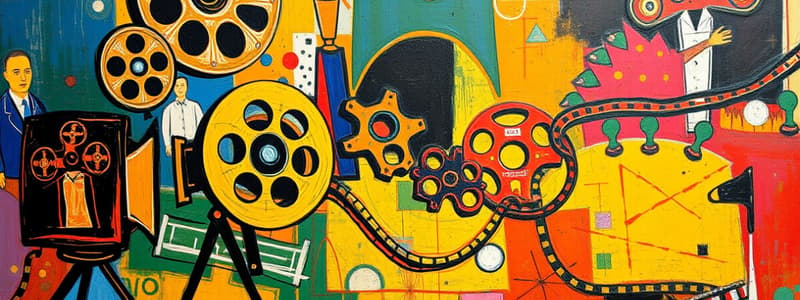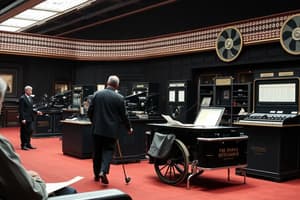Podcast
Questions and Answers
What is the camera obscura?
What is the camera obscura?
- A darkened box with a convex lens (correct)
- A film editing technique
- A type of early photography technique
- A motion picture device
Who developed the camera gun?
Who developed the camera gun?
Etienne Jules Marey
What significant motion picture did Edward Muybridge create?
What significant motion picture did Edward Muybridge create?
Galloping horse motion picture
What does MPPC stand for?
What does MPPC stand for?
What was William Dickson's contribution to cinema?
What was William Dickson's contribution to cinema?
What invention is George Eastman credited with?
What invention is George Eastman credited with?
Name the film directed by Edwin S. Porter in 1903.
Name the film directed by Edwin S. Porter in 1903.
What notable film did George Melies create?
What notable film did George Melies create?
Who founded Universal Pictures?
Who founded Universal Pictures?
What was significant about the film 'Birth of a Nation'?
What was significant about the film 'Birth of a Nation'?
What was the profession of Fatty Arbuckle?
What was the profession of Fatty Arbuckle?
What was Charlie Chaplin known for?
What was Charlie Chaplin known for?
What title is associated with Buster Keaton?
What title is associated with Buster Keaton?
What does 'persistence of vision' refer to?
What does 'persistence of vision' refer to?
What is a magic lantern?
What is a magic lantern?
What is the kinetoscope?
What is the kinetoscope?
What is a vitascope?
What is a vitascope?
What type of theater was Koster and Biol's Vaudeville Theater?
What type of theater was Koster and Biol's Vaudeville Theater?
What are 'chasers' in film?
What are 'chasers' in film?
What is flexible film?
What is flexible film?
Flashcards are hidden until you start studying
Study Notes
Key Figures in Motion Pictures
- Gian Batista Porta: Innovator of the camera obscura, crucial in the evolution of photography.
- Etienne Jules Marey: Developed the camera gun, a device that could capture a series of images in rapid succession.
- Edward Muybridge: Known for creating the first motion picture of a galloping horse, setting a precedent for future filmmaking.
- Thomas Edison: Instrumental in the formation of the MPPC ("the trust"), controlling film production and distribution.
- William Dickson: Creator of the kinetoscope and founder of Biograph, significantly contributing to early cinematic technology.
- Norman Raff & Thomas Armut: Inventors of the movie projector, enhancing the public's ability to view films.
- George Eastman: Introduced flexible film stock, revolutionizing the film industry by making production more practical.
Early Films and Cinematic Techniques
- Edwin S. Porter: Director of "The Great Train Robbery," one of the first narrative films.
- George Melies: Known for "A Trip to the Moon," a pioneer of special effects in cinema.
- Carl Laemmle: Established the IMP, founding Universal Pictures and shaping the studio system.
- William Fox: Founded Fox Studio, notable for employing vertical integration in film production and distribution.
- Adolph Zukor: Introduced feature-length films, leading to the establishment of Paramount Pictures.
Influential Directors and Filmmaking Styles
- D.W. Griffith: Creator of "Birth of a Nation," considered a significant figure in film history for elevating movies to an art form with a focus on naturalistic acting.
- Mack Sennett: Credited with creating the comedic style of the "laugh factory," famous for the Keystone Kops.
Notable Innovations and Concepts
- Lev Kuleshev: Demonstrated the power of film editing, showcasing how sequence and juxtaposition can influence viewer perception.
- Persistence of vision: Optical illusion contributing to motion perception in cinema, foundational for animated films.
- Kinetoscope: An early motion-picture device where images were viewed through a peephole.
Iconic Stars and Their Contributions
- Fatty Arbuckle: A working-class comedian involved in a controversial murder trial that affected Hollywood.
- Charlie Chaplin: Renowned for his unique blend of comedy and pathos, becoming the most successful comic of the early 20th century.
- Buster Keaton: Known for his physical comedy and inventive acrobatics, epitomized in films like "The General."
- Mary Pickford: First true movie star and dubbed "America's sweetheart," instrumental in early Hollywood.
- Douglas Fairbanks: Action hero of silent films, known for his swashbuckling roles.
- Lilian Gish: Griffith's favorite actress, left a lasting impact on early cinema.
Cultural Impact of Early Cinema
- Clara Bow: Represented "flaming youth" in the 20s, branded as the "It" girl.
- Rudolph Valentino: Iconic "Latin lover," a significant figure representing romantic male leads in film.
- Laurel & Hardy: Comedic duo famous for their contrasting personalities, labeled as "two minds without a single thought."
Historical Milestones in Film
- "The Great Train Robbery" (1903): Pioneering film that marked the beginning of narrative cinema.
- "A Trip to the Moon" (1902): Groundbreaking in special effects and storytelling by George Melies.
- "Birth of a Nation" (1926): Griffith's controversial film, noted for its film propaganda and technical advancements.
- "Nosferatu": A landmark in German Expressionism directed by F.W. Murnau.
- "Wings" (1927): Awarded the first-ever Oscar for Best Picture.
Important Film Technologies
- Camera obscura: Historical device projecting external images inside, significant in photography's development.
- Magic lantern: Early image projector used for showing photographic slides, a precursor to modern projectors.
- Vitascope: One of the first motion-picture projectors invented by Edison.
- Flexible film: A crucial advancement in film technology, facilitating production and distribution across the industry.
Studying That Suits You
Use AI to generate personalized quizzes and flashcards to suit your learning preferences.




